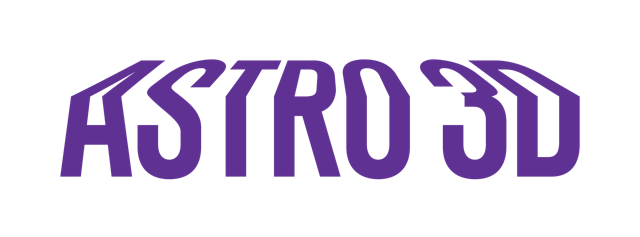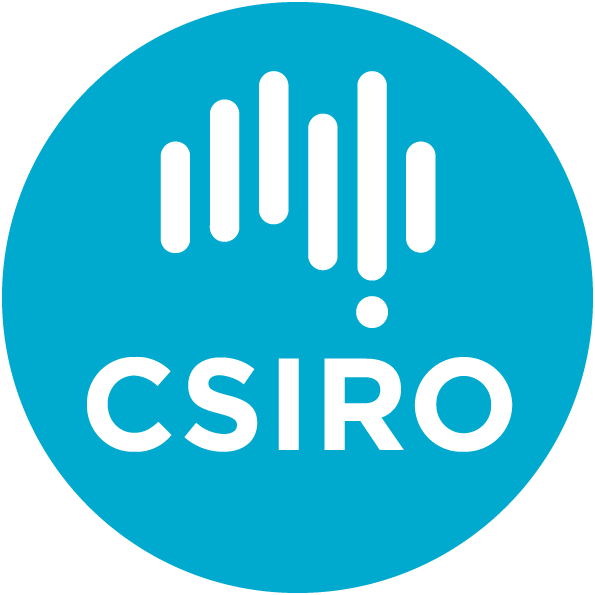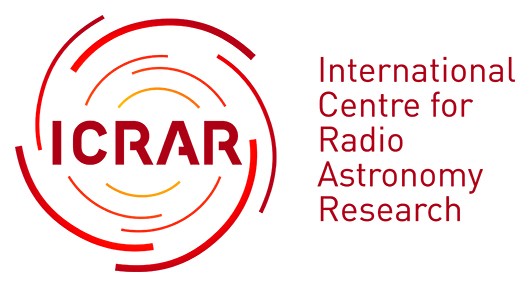August 2022
Editor: Tristan Reynolds
Foreword
Tristan Reynolds
Welcome to the August 2022 edition of the WALLABY newsletter! It has been an eventful past six months with preparing for the pilot survey phase 1 public data release, nearing completion of pilot survey phase 2 and preparing for the full survey, which will start later this year! I will be stepping down as the WALLABY newsletter editor after this edition so if anyone is interested in taking over the newsletter editor role please contact the WALLABY management team or myself. I am also happy to answer any questions about the role of newsletter editor.
In this issue, we have a science update from the recently accepted paper by Bumhyun Lee on his study looking at the effect of the environment on molecular gas in group galaxies and updates on the full survey field selection and the 10 arcsec imaging pipeline being developed by Chandra Murugeshan. We also welcome 5 new WALLABY members who have joined since February. We have updates from Technical Working Groups 4, 5, 6 and 7 and Science Working Group 1. Happy reading!
Message from the PI
Lister Staveley-Smith
As is reported elsewhere in this Newsletter, the Review of ASKAP Science Survey Projects (RASSP) concluded in April this year, resulting in a substantial allocation of observing time to WALLABY over the next 5 years. The RASSP committee noted the ambitious and potentially transformational nature of WALLABY, its outstanding legacy value, excellent publication rate and good record of student involvement. Well done Team WALLABY, but this is only the beginning! Preparations, including an upcoming busy week, are now underway for the start of full survey operations.
I also wish to acknowledge and thank Tristan for producing the WALLABY newsletter over the last 2.5 years. Under Tristan, the Newsletter has continued to be an interesting read every six months, so we thank him for his dedication, timeliness and professionalism. Unfortunately, that means we are now in need of a new editor, so we encourage aspiring editors to contact Tristan himself, or any member of the management team to discuss!
Message from the project manager
Tobias Westmeier
2022 has been a highly successful year for WALLABY so far. To begin with, WALLABY was awarded almost 9000 hours of ASKAP observing time over the next five years during the SSP review process, the outcome of which was announced in early April. This is the largest allocation (both in absolute terms as well as relative to our time request) of any SSP, so congratulations and thank you to the entire team for helping with the RASSP proposal and contributing to a compelling science case for WALLABY.
Phase 2 of the pilot survey is nearly complete at this stage, and close to a thousand galaxies in the NGC 4808 field and parts of the NGC 5044 mosaic have already been picked up by the SoFiA 2 source finding pipeline and made available to the WALLABY team for scientific analysis. At the same time, the public release of source finding and kinematic products from phase 1 of the pilot survey is making good progress. The two associated data release papers have received favourable referee reports, and revised versions will soon be resubmitted to the journal. A media release that will accompany this first public release of WALLABY data is also in preparation. I would like to use this opportunity to thank the AusSRC, CADC, CASDA and CIRADA teams for their significant effort over the past few months in getting the data ready for public distribution through the CASDA and CADC data servers.
The next highlight for WALLABY this year will be the upcoming Busy Week in August, the aim of which is to prepare our strategies, pipelines and processes for the full survey. We currently expect ASKAP survey observations to commence in late 2022, which would be a fitting end to a successful year for the WALLABY project.
Message from the project scientist
Karen Lee-Waddell
In May 2022, the last set of WALLABY data was ingested onto Galaxy, marking the end of Pilot Phase 2 (from the observations side of things) for our Survey Science Project (SSP) and the winding down of Galaxy at the Pawsey Supercomputing Centre.
Looking back at the history of WALLABY observations, Figure 1 shows a long and fruitful journey: one paper from BETA, five from Early Science, four from pre-pilot, and three published papers from Phase 1 thus far. Not to mention the various technical, overview, and other WALLABY-related papers that have not been included in the summary figure. The main survey has yet to begin but WALLABY members continue to produce interesting ASKAP science from small patches of sky coverage.
The end of ASKAP Pilot Phase 2 also coincides with the start of Setonix Phase 1. Researchers are busily migrating their work from Galaxy and Magnus to the new marsupial-named supercomputer, which promises to be much faster while providing enhanced data sharing capabilities. After attending some of the training offered by Pawsey, I’m glad to report that Setonix and Acacia object storage are not too scary and in some aspects, possibly easier to use than other Pawsey systems.
Looking forwards, WALLABY is preparing for ASKAP full science mode. With a top SSP ranking, WALLABY has an allocation of 8832 hours of observing time (equivalent to 552 x 16hr integration tiles) over five years. Currently, the team is iterating on an observing strategy that will enable the best amount of potential science on the over-subscribed survey telescope.
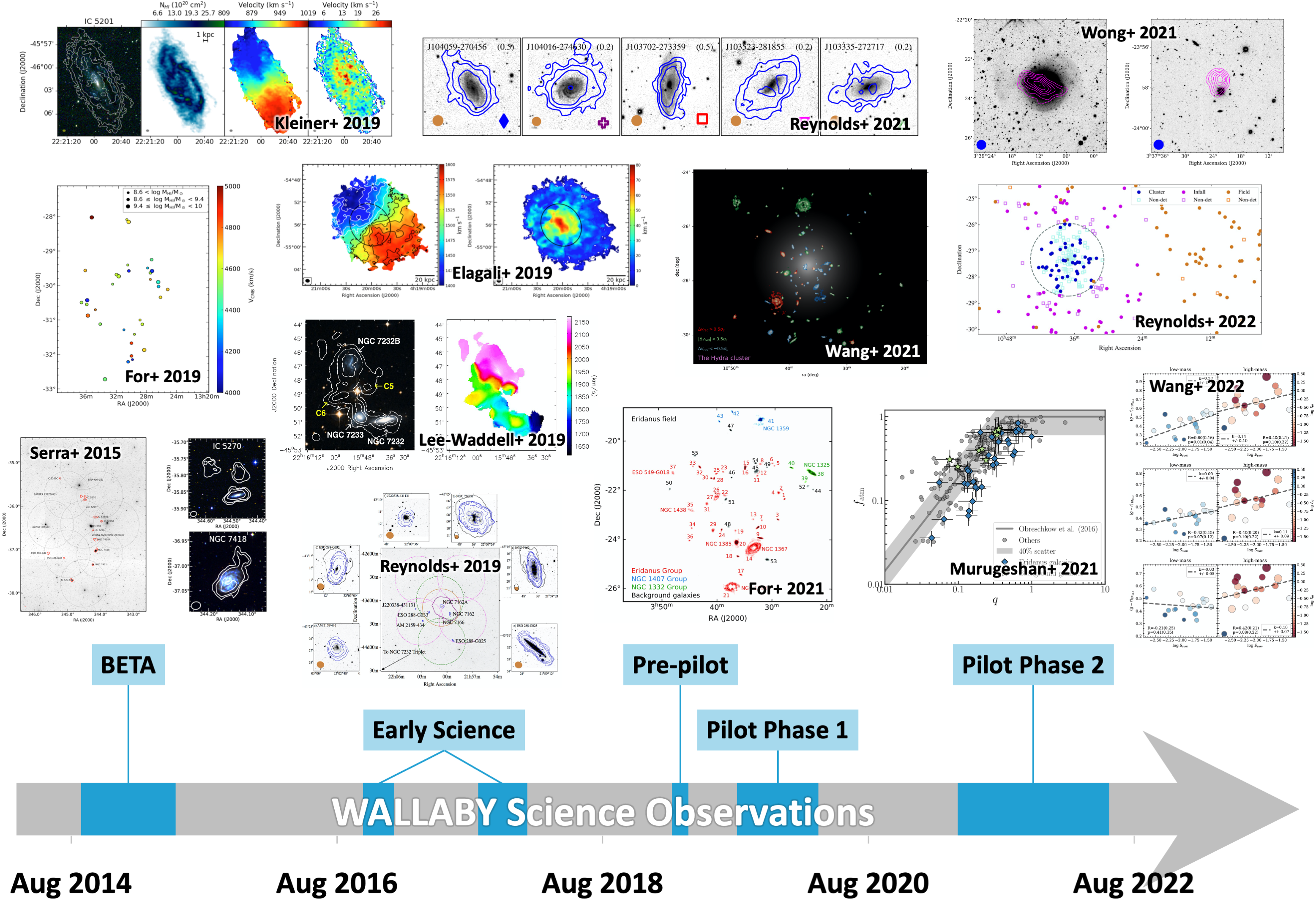
New Member Profiles
Ananthan Karunakaran
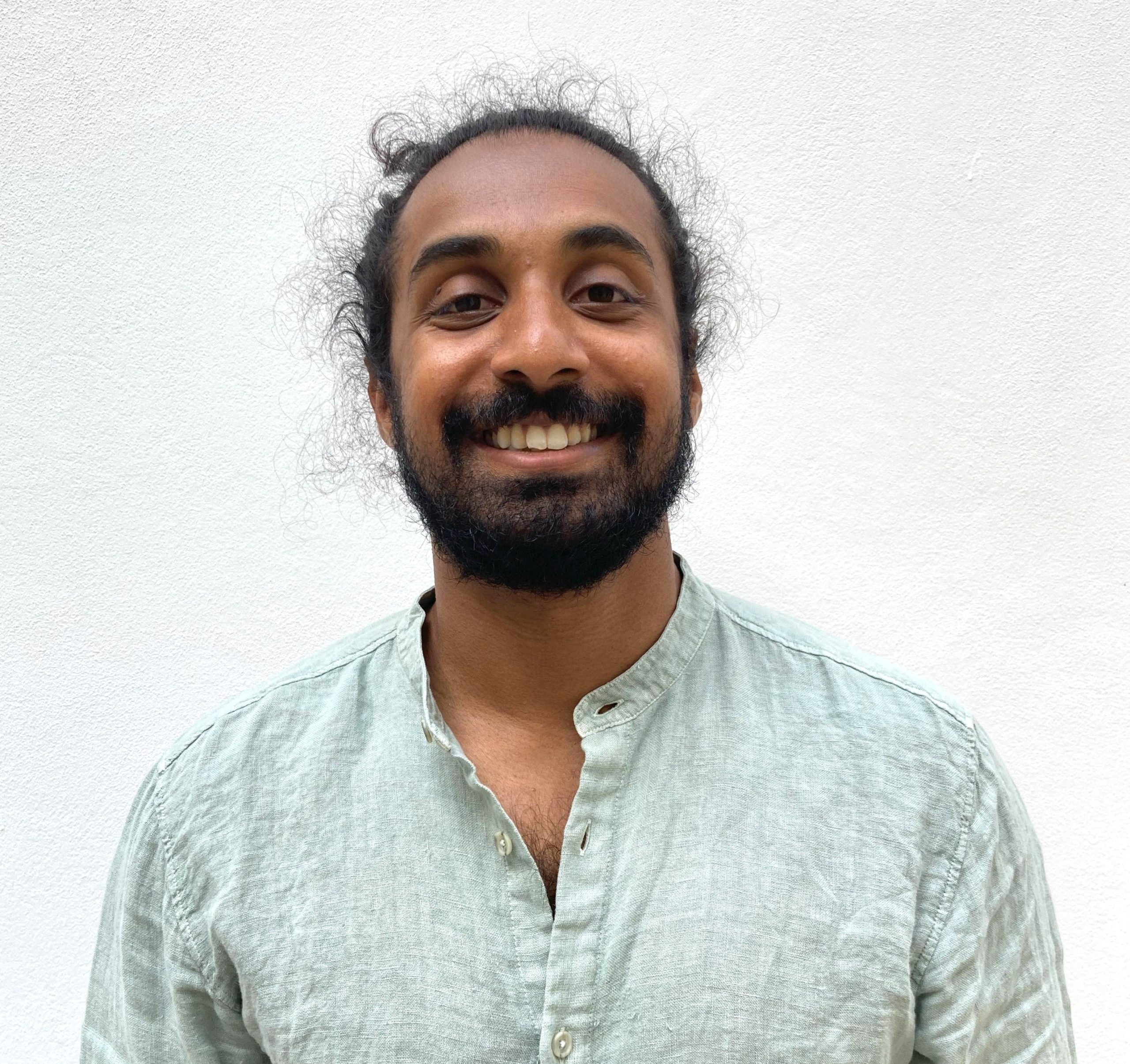
Hi! I am a postdoctoral researcher at the Instituto de Astrofísica de Andalucía (IAA-CSIC) in Granada, Spain. My primary research interests focus on galaxy evolution of dwarf galaxies, particularly dwarf satellites around Milky Way-like systems and low surface brightness dwarf galaxies including the peculiar class of Ultra-Diffuse Galaxies. I am keen on characterizing the star-forming and HI properties of these systems in order to understand the effects of internal and external processes on their evolution and place constraints on theoretical predictions from simulations. My interests natural fall in line with several of the goals within the WALLABY survey and look forward to interesting scientific collaborations.
In addition to my research interests, I am aiding in the development of the Spanish prototype of a SKA Regional Center (SPSRC) and the distribution of WALLABY data products.
Richard McDermid
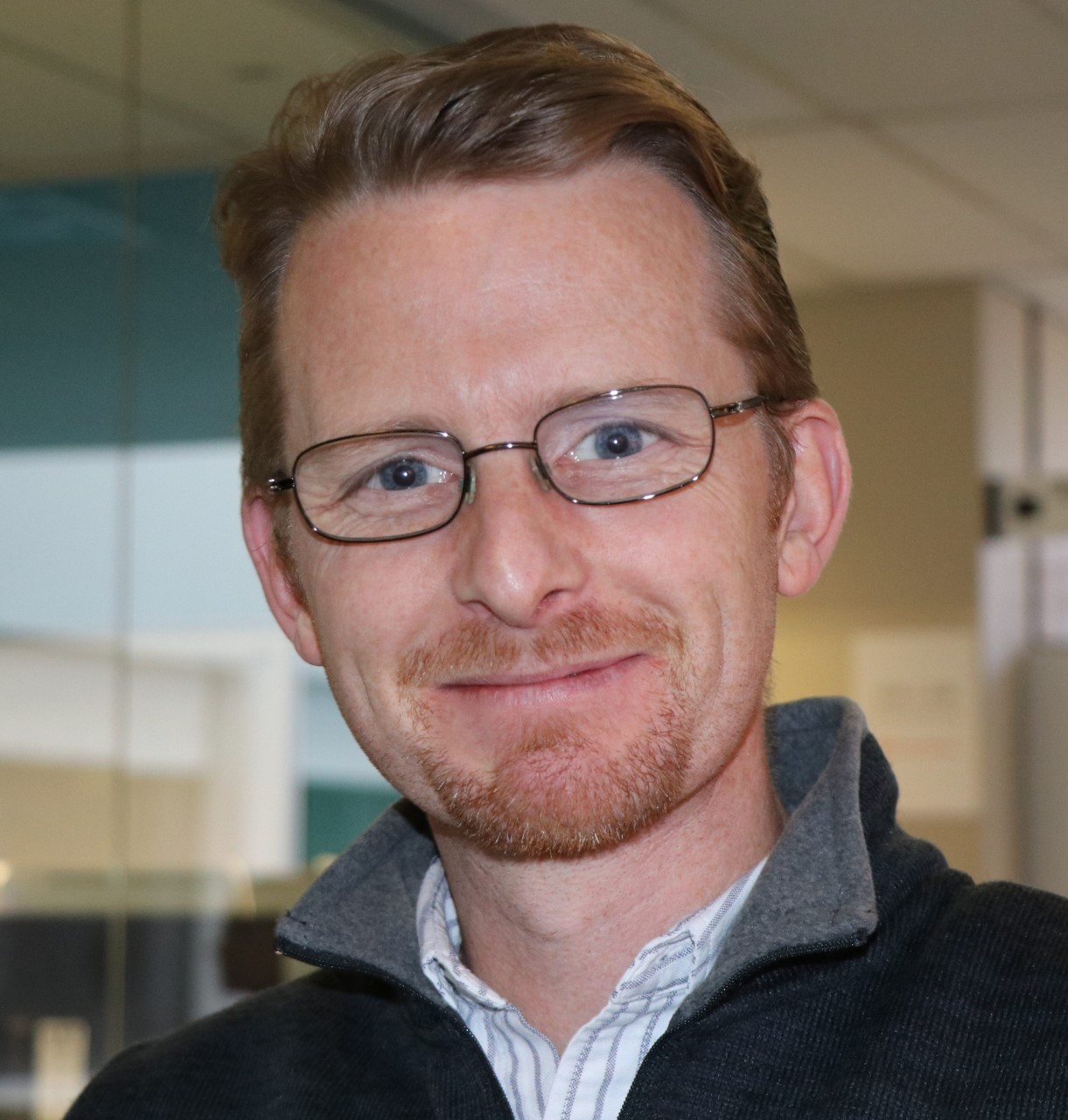
I am Director of the Research Centre for Astronomy, Astrophysics and Astrophotonics (MQAAAstro), and ASTRO 3D Node Leader at Macquarie University. My research interests are primarily around the chemical and dynamical evolution of galaxies, mainly through combined modelling of spatially-resolved stellar populations and kinematic tracers of galaxies near and far. I also work in instrumentation at optical and infrared wavelengths, and am Project Scientist of the new Australian-led ESO/VLT Adaptive Optics Facility instrument, called “MAVIS”, due to be on-sky early 2028.
My main interests in WALLABY are in combining the dynamical analysis of HI with stellar and ionised gas dynamics, in order to probe the detailed dark and luminous mass distribution in galaxies; and in developing new tools for combining HI and optical IFU data studies, within the ASTRO 3D theme of Data-Intensive Astronomy.
Maria Angeles Mendoza
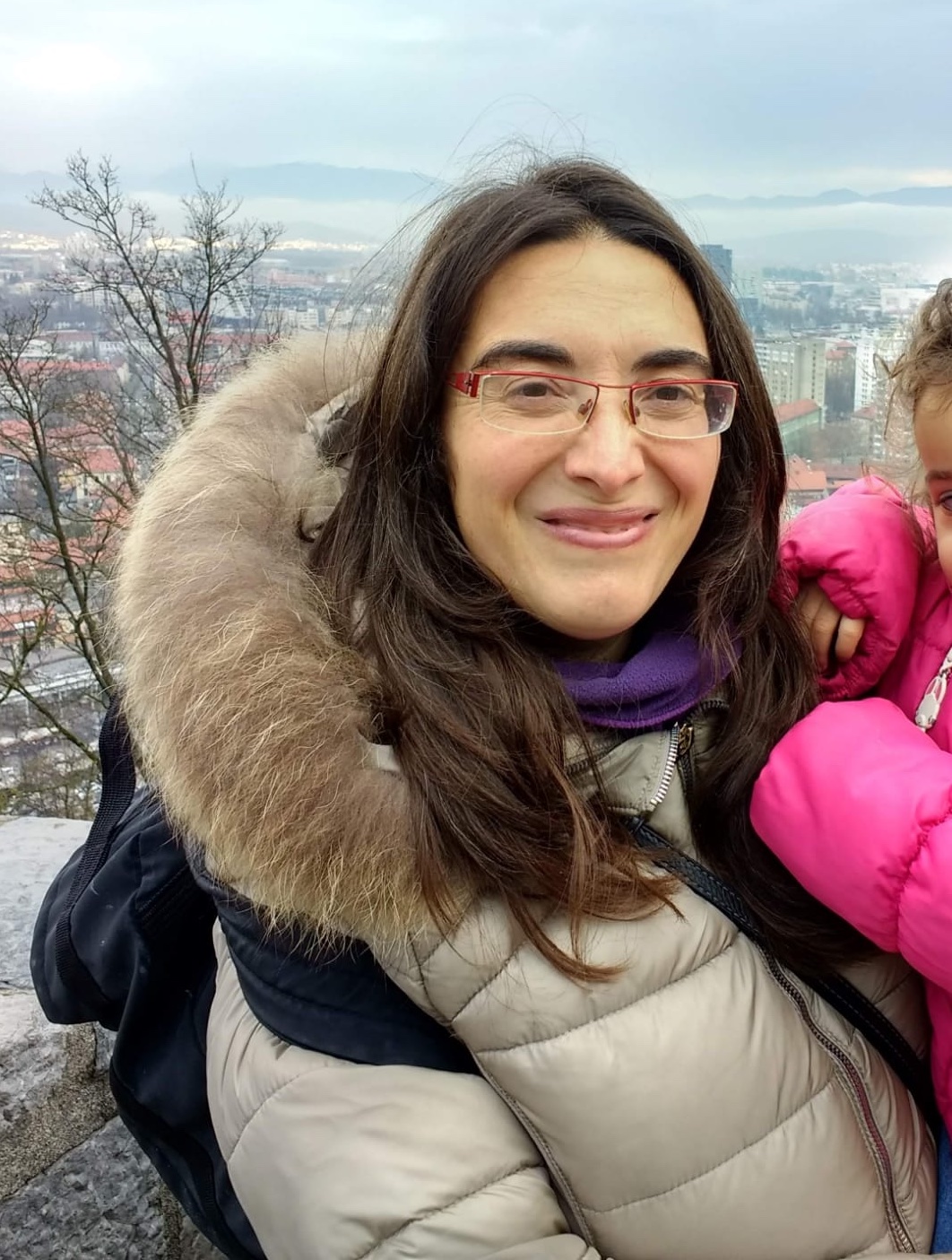
Hi! I’m Maria Angeles, I have a degree in Physics and a PhD Computer Science and Artificial Intelligence, both at the University of Granada (Spain), where I worked as Graduate Teaching Assistant for more than 5 years, mainly teaching Computer Science. I’m experienced as a programmer in scientific projects, working in international cooperative environments, such as the projects “Calar Alto Legacy Integral Field Area (CALIFA) survey” (IAA-CSIC), “Preparing for Euclid mission” (IEEC-CSIC) and “UGR contribution to PLATO2.0” (University of Granada). Currently, I am a science-domain services engineer at the IAA-CSIC. I am contributing to the development of the Spanish prototype of SKA Regional Centre (SPSRC) and my work is mainly focused on archive services, paying special attention to VO services. I’m very happy to join the WALLABY team and I hope this is the beginning of a beautiful friendship.
Tamsyn O’Beirne
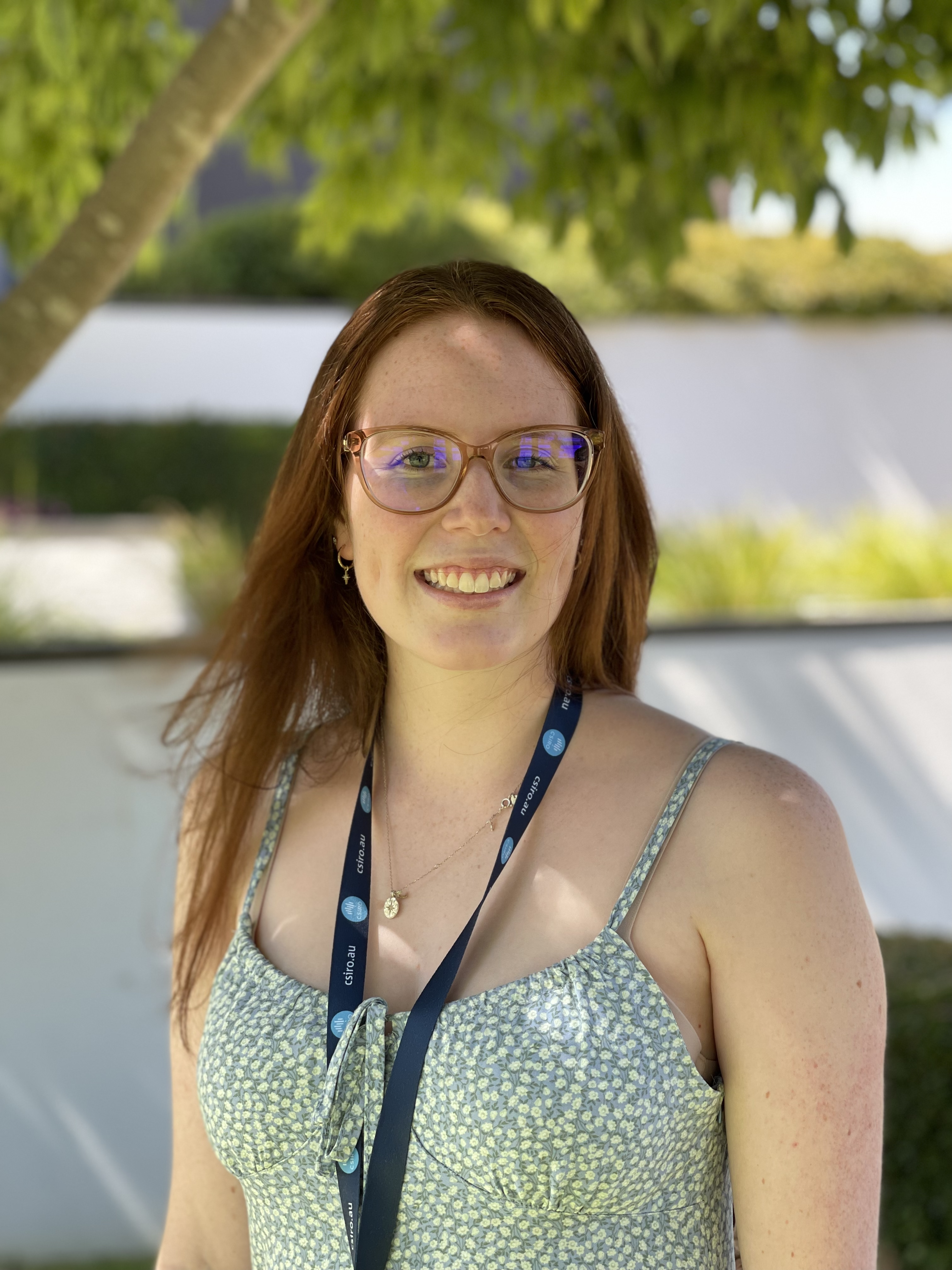
Hello! I am an astronomy and astrophysics masters student at ICRAR-UWA. I completed my Bachelor of Science majoring in physics at the University of Melbourne in 2021. Throughout my undergraduate degree I completed several research based astrophysics internships with ICRAR-Curtin, CSIRO Space and Astronomy and the Laby Research Scholars Program at the University of Melbourne. My current research is being supervised by Professor Lister Staveley-Smith and Dr Ivy Wong. I am using the HI detections from WALLABY to look for dark galaxies and to investigate the properties of low surface brightness galaxies. I look forward to completing my masters and being a part of the WALLABY team.
Manu Parra-Royon
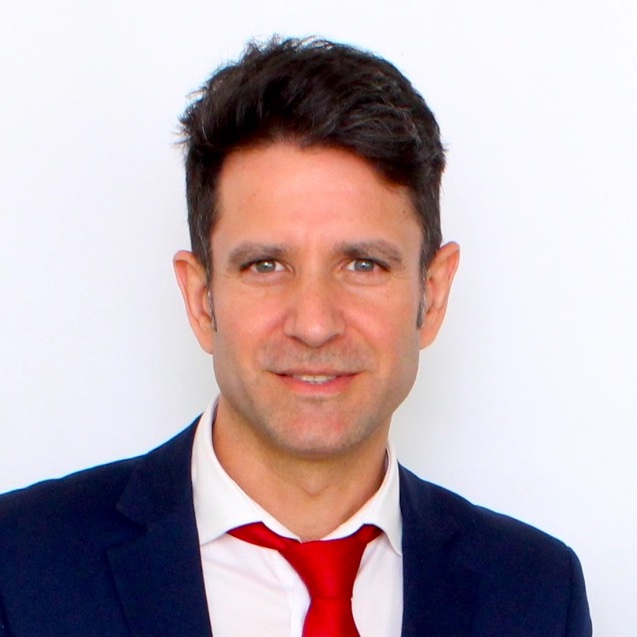
Hi WALLABIES!
My name is Manu, I studied Computer Engineering and I hold a PhD in Computer Science and Artificial Intelligence from the University of Granada (Spain). I’ve developed my professional life mainly in industry, working as a development, data processing and cloud engineer in several sectors. In the last years I jumped to academia, where I’ve worked as researcher at the University of Granada, with projects related to Smart Agriculture, Optimisation, AI/ML and BigData. Then I’ve been involved in exa-scale data experiments for High Energy Physics (protoDUNE) at CERN (Geneva, Switzerland) and currently I’ve joined as Post Doctoral Researcher at the IAA-CSIC (Spain), within the design and implementation team of the Spanish SKA Regional Centre (SPSRC) prototype. In this context I play the role of Tech Leader and Scrum Master of one Stream Aligned Team in charge of providing support for SRC Network prototypes in Data Distribution, Computing/Processing, Science Platform and Software. As for WALLABY, I’m a member of the WG7.2 group since one year ago and I am actively involved in the development of the distribution platform for WALLABY data products.
WALLABY Field Selection Process
by Karen Lee-Waddell and Lister Staveley-Smith
The 2021 Review of ASKAP Survey Science Projects (RASSP) recommended an allocation of 8,832 hrs to WALLABY over a 5-year period, which is less than the 12,480 hrs required for covering the entire southern hemisphere (an already de-scoped goal from the original 2009 proposal of surveying the entire sky south of declination +30 deg).
With that still fairly positive RASSP outcome, now the task for WALLABY is to determine an observing strategy that maximises potential science output, has significant legacy value, is commensal with other SSPs, overlaps with various multi-wavelength surveys, and fits within the current confines of ASKAP. The front-running strategy involves covering a large “core” contiguous region across specific declination ranges and reserving some time to observe smaller outlying “extension” areas of key interest. To aid in the discussion and decision-making process, WALLABY memo 26 details two different core regions (see below in Figures 2 and 3) and various possible extensions. WALLABY memo 27 (in prep) presents a census of current and upcoming multi-wavelength surveys relevant to WALLABY science.
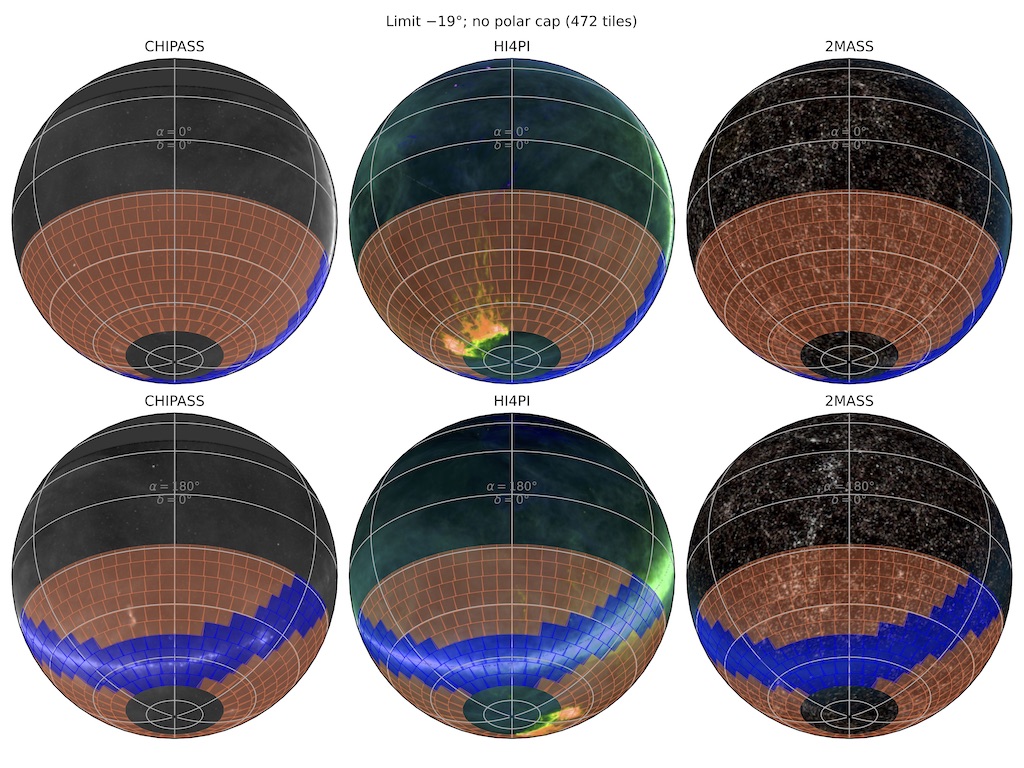
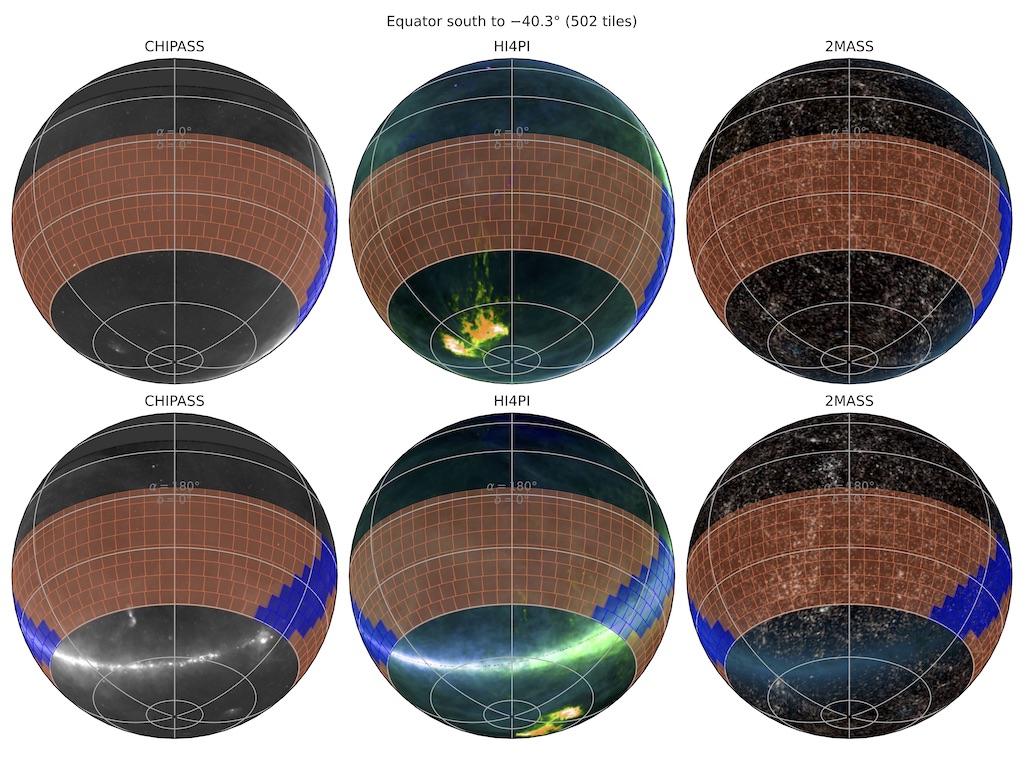
Concurrently with the WALLABY field selection process, the ASKAP Operations team is running observing simulations using its SAURON scheduling bot, which takes into account representative survey fields from every SSPs as well as various observing and scheduling constraints. The hope is have a 5-year observing plan that accommodates all SSP science requirements and efficiently uses ASKAP to its full potential.
Tune-in to our monthly WALLABY science meetings (on the third Thursday of the month, with alternating time-zone coverage) for updates on this process.
ALMA/ACA CO Survey of the IC 1459 and NGC 4636 Groups: Environmental Effects on the Molecular Gas of Group Galaxies
by Bumhyun Lee
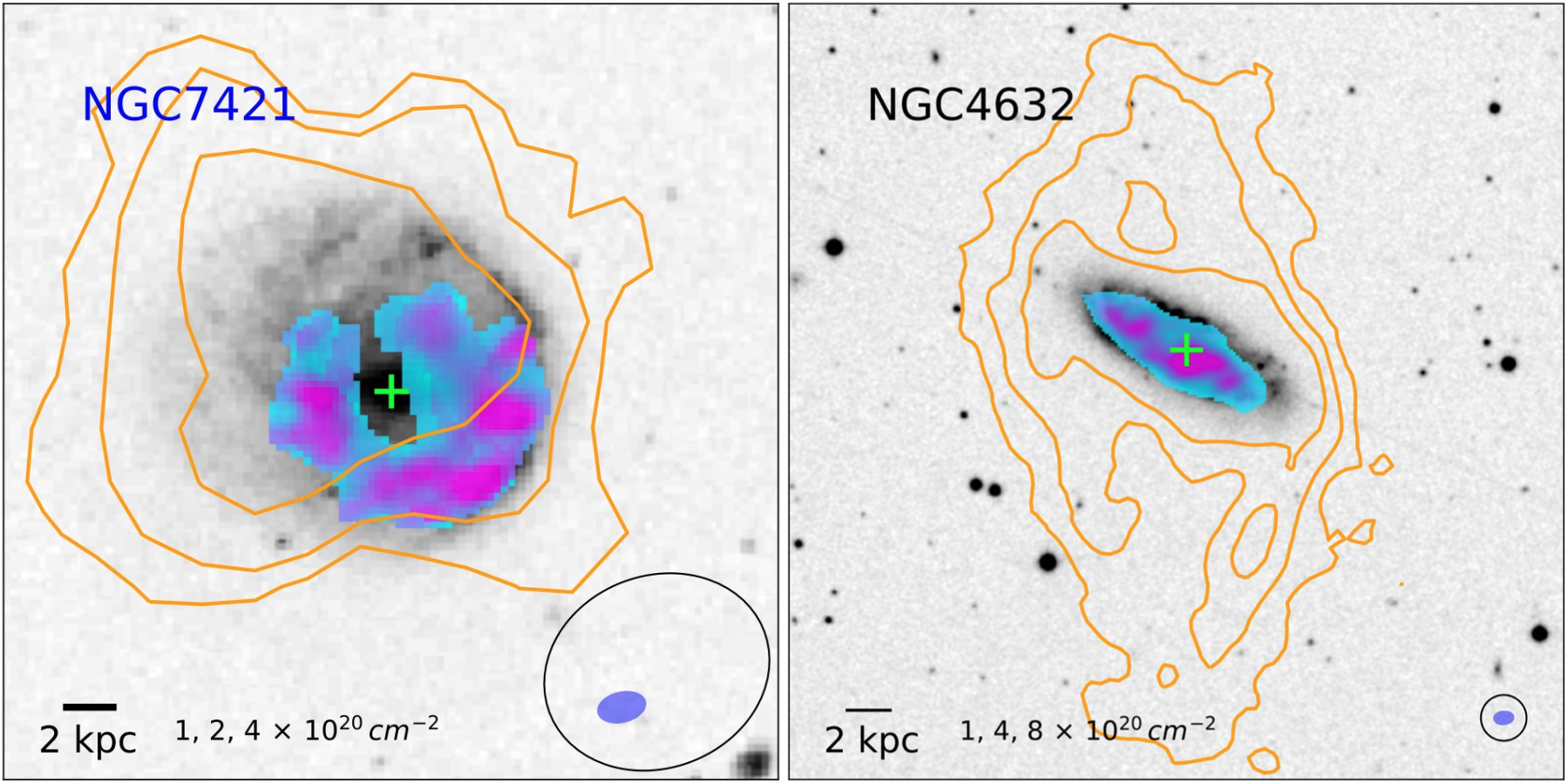
This work has been recently accepted for ApJS. In this paper, we present new results of CO imaging observations using the Atacama Compact Array (ACA) for 31 HI-detected galaxies in the IC1459 and NGC4636 groups. This is the first CO imaging survey for loose galaxy groups.
By comparing our ACA CO data with multi-wavelength data (HI, IR, UV, and including ASKAP HI images), we investigate the effects of the group environment on the cold gas components and star formation activity. We find that CO and/or HI morphologies are asymmetric and disturbed in our group sample (e.g., NGC 7421 and NGC4632, see Figure 4). In comparison with the xCOLD GASS sample, our group members tend to have low SFRs and low H2 gas fractions (Figure 5). These results suggest that the group environment can change the physical properties of group galaxies.
The link for the paper: https://arxiv.org/abs/2204.06022

Update on the 10 arcsec Imaging Pipeline
by Chandra Murugeshan
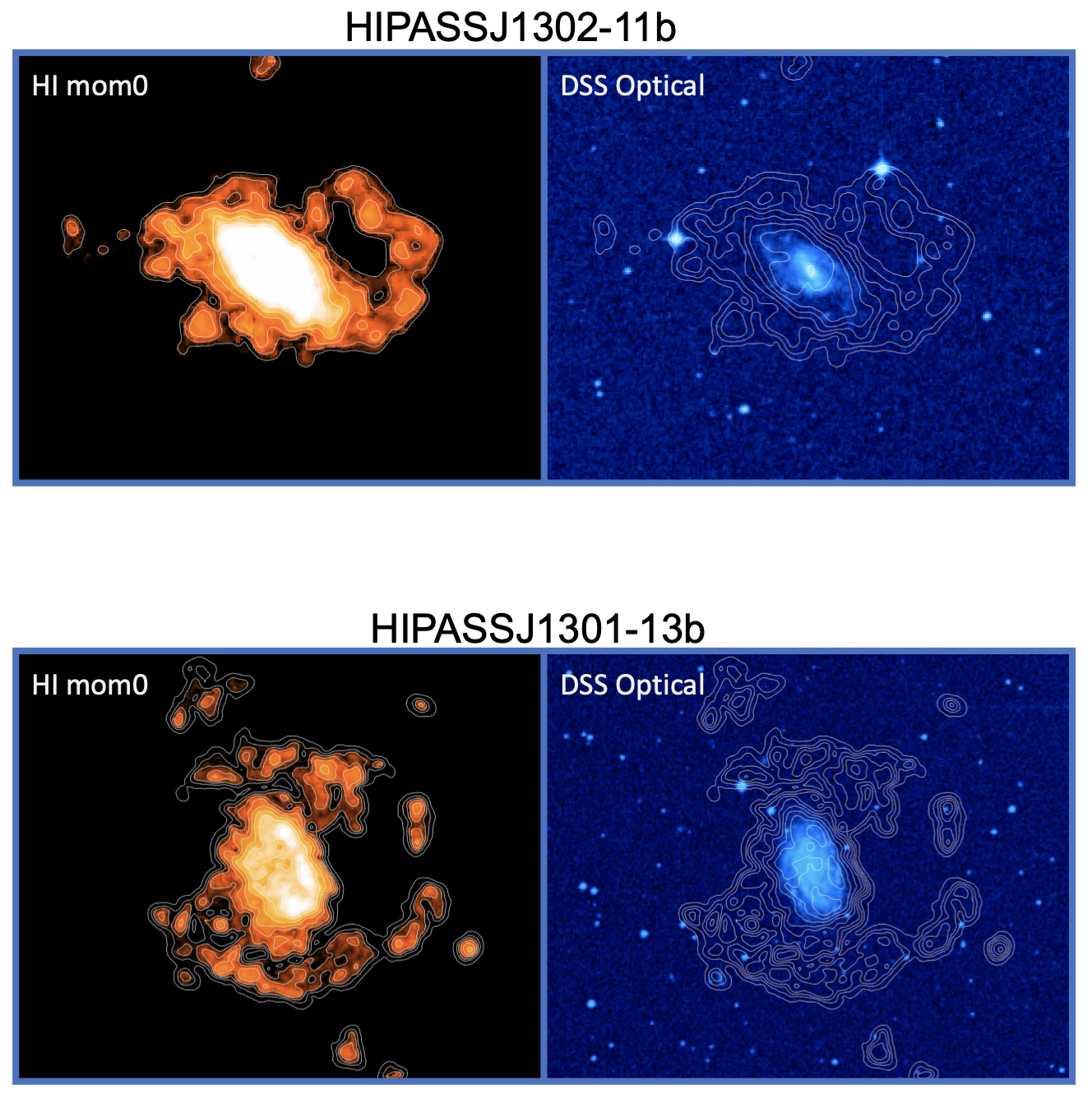
The WALLABY survey is expected to detect ~300,000 HI sources within the local Universe (z < 0.1), with a default spatial resolution of 30 arcsec. A fraction of these detections (a few thousands) are likely to be well resolved in HI. These primarily comprise of the bright and extended HIPASS sources. As part of the full survey, WALLABY intends to image these well-resolved galaxies in 10 arcsec resolution (postage stamps), using the full potential of the ASKAP telescope.
In this regard, I have been working on building an imaging pipeline that automatically images batches of galaxies in high-resolution. The various stages of the pipeline include – splitting-out the visibility data (for a narrow frequency range, or 250 channels) from the beams containing the source and uploading the data on to CASDA. Downloading the data on to Magnus and running the imaging pipeline, which uses the ASKAPSoft modules and tasks including the “imager” task to make the high-resolution images using the longest baselines, followed by “imcontsub” which performs the image-based continuum subtraction and finally, “linmos”, which applies the holography-based primary beam correction to the data. Once these tasks are completed for all beams corresponding to a source, they are then mosaiced to form the final image cube. I’m happy to report that the 10 arcsec imaging pipeline has been successfully tested on the Pawsey machine Magnus to image the HIPASS sources from the NGC 5044 tile 1 field, as part of the Pilot Phase II observations.
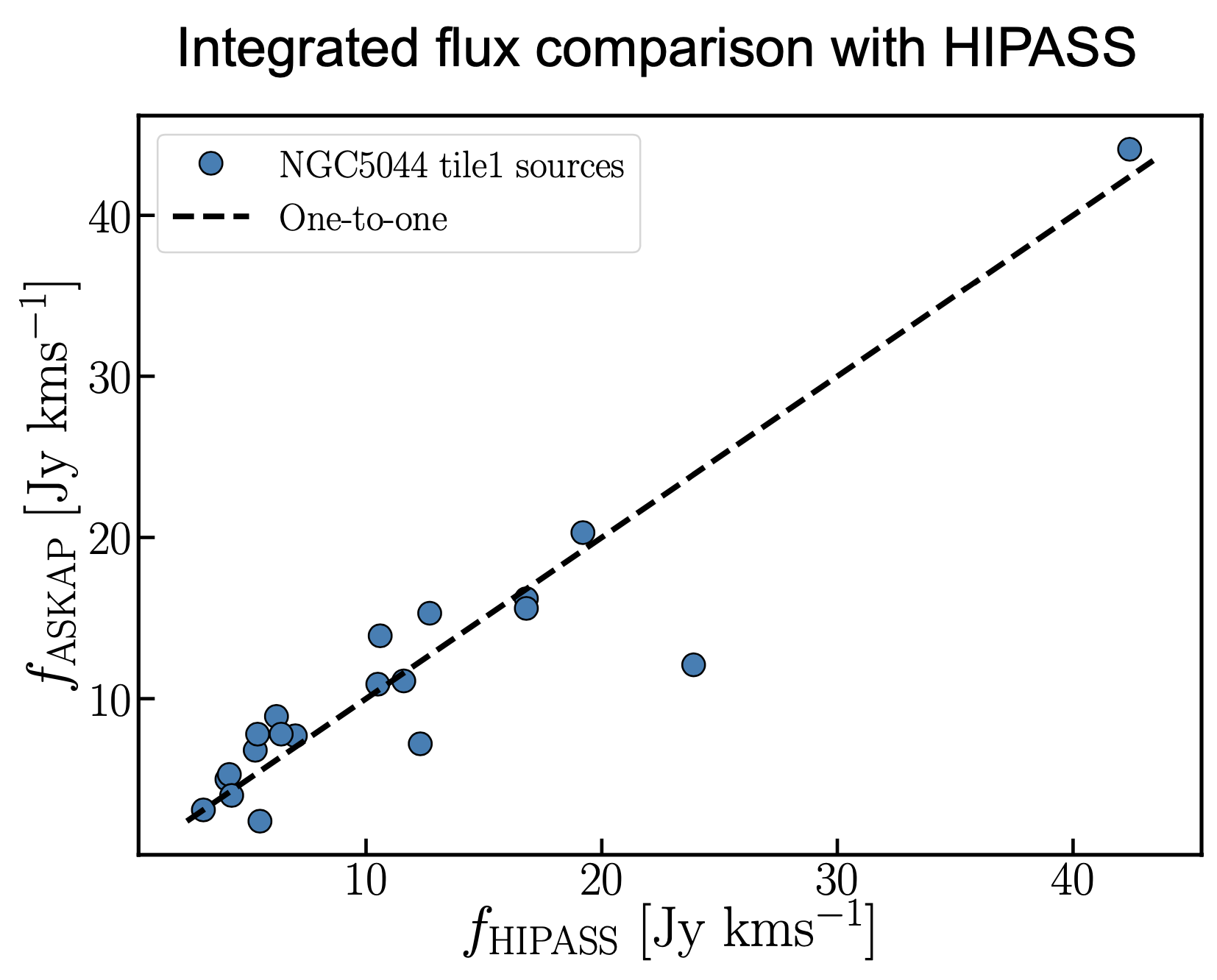
22 of the 23 galaxies were imaged successfully with a total wall run time of ~ 2 hours. The quality of the images is very good (see Figure 6), with the rms in the image cubes ranging from 1.6 to 2.5 mJy/beam per channel, with a median observed rms of 1.9 mJy/beam. As a sanity check, the integrated flux of the sources was also compared with their HIPASS fluxes and overall, we observe a good one-to-one correspondence (see Figure 7). The next step is to run the pipeline to image the rest of the sources from the phase 2 fields (over ~60 sources in total). In addition, we have plans to containerise the pipeline and port it over to the new Pawsey machine Setonix for some early tests, thereby making sure the pipeline is in working condition before full surveys start end of the year.
TWG 4 – Source Finding and Cataloguing
by Tobias Westmeier on behalf of TWG 4
The source finding working group has been busy running the SoFiA 2 source finding pipeline on the new data from phase 2 of the WALLABY pilot survey. So far, close to 1000 galaxies have already been detected in the NGC 4808 field and part of the NGC 5044 four-tile mosaic. These have been internally released to the entire WALLABY team for scientific analysis as NGC 4808 DR1 and NGC 5044 DR1 and 2. Thanks to the great support from Austin Shen and the Australian SKA Regional Centre (AusSRC) we have been able to make the data accessible through our new dedicated WALLABY data archive, with easy-to-use Python notebooks replacing the old Dropbox links from phase 1 of the pilot survey.
The number of detections so far is already significantly higher than in all of phase 1, highlighting the additional improvements that have been made to the observing strategy, data reduction pipeline and source finding approach since then. Further improvements, in particular to continuum subtraction and RFI flagging, are expected to increase the detection rate even further in the future and should get us close to the detection rate predicted by the WALLABY reference simulation for the full survey.
In late June, the team released a new stable version 2.5 of the SoFiA source finder via GitHub (https://github.com/SoFiA-Admin/SoFiA-2/releases/tag/v2.5.0). New features and improvements include the generation of a position–velocity diagram for each detection, improved structuring and metadata recording in SoFiA’s output files and the fixing of a few minor bugs in the code. A complete list of changes can be found in the release notes on GitHub. As usual, we invite SoFiA users to send us feedback and bug reports, either via the GitHub issue system or directly via e-mail.
Another new development led by Kelley Hess is the SoFiA Image Pipeline (SIP) which has been made available on GitHub (https://github.com/kmhess/SoFiA-image-pipeline). SIP allows the automatic generation of a wide range of image products based on output from SoFiA and will be a great tool for visualising and checking the quality of source finding runs. Examples of plots that SIP can generate for each individual SoFiA detection include integrated spectra, position–velocity diagrams, moment maps and an overlay of HI contours on multi-wavelength images (see Figure 8).
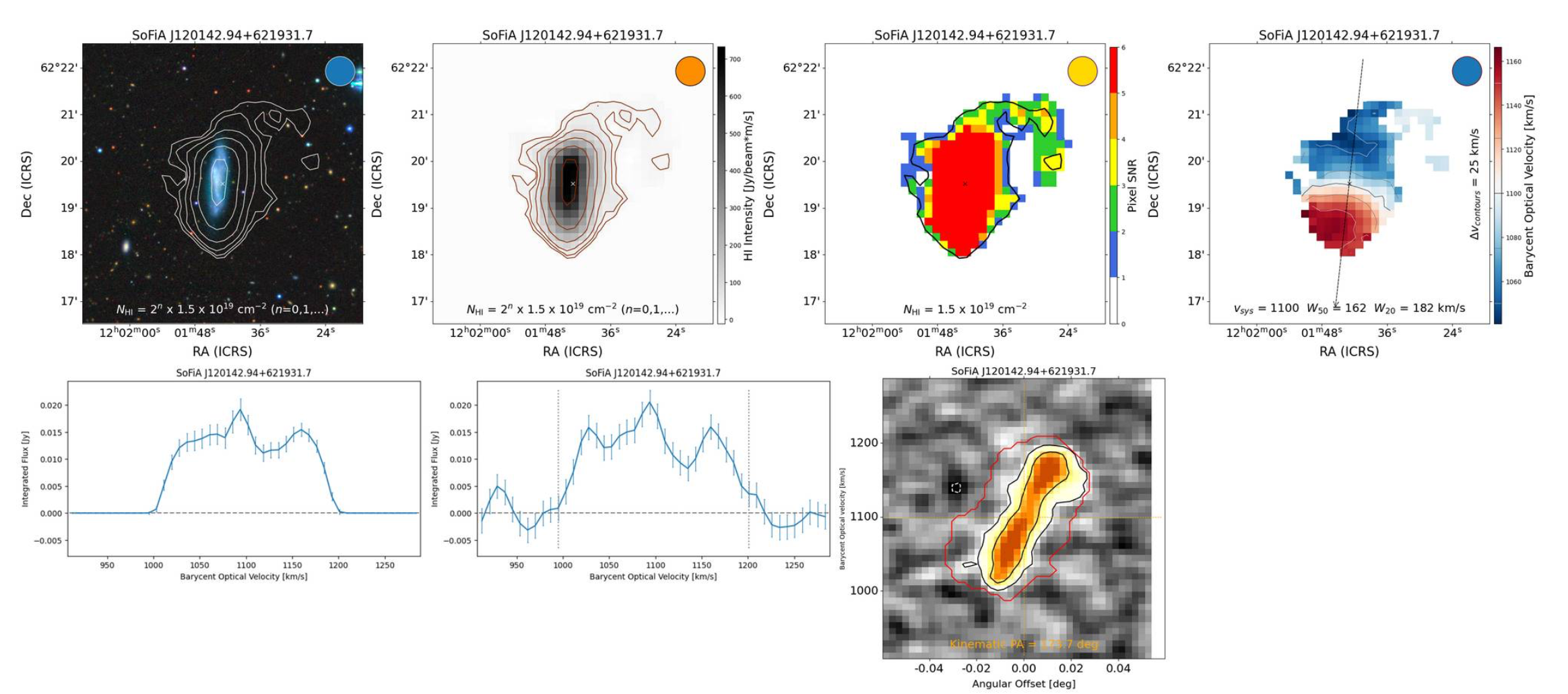
TWG 5 – Kinematics Pipeline
by Kristine Spekkens
Technical Working Group 5 (TWG 5) continues to work on kinematically modelling spatially-resolved WALLABY detections.
Work in recent months has focussed on finalising the Pilot Survey Phase 1 detection kinematic model public data release. Automatically and homogeneously-generated kinematic models for over 100 Public Data Release 1 (PDR1) detections will be made available to the public through CSIRO ASKAP Science Data Archive (CASDA) and the Canadian Astrophysics Data Centre (CADC). A detailed description of kinematic modelling process, results, data availability and a first analysis of the population of galaxies modelled are the focus of a paper led by WALLABY team member Nathan Deg (Queen’s University, Canada) that will soon appear in the Publications of the Astronomical Society of Australia (PASA). Work is now underway to analyse Pilot Survey Phase 2 detections, and is being led by WALLABY team member Rebecca Halloran (Queen’s University, Canada).
Another aspect of TWG 5 work is the development of a custom-built kinematics pipeline for full WALLABY: the WALLABY resolved kinematics pipeline (WRKP). Most of the pipeline elements are now in place, including a novel 3D bootstrap-resampling algorithm to estimate statistically robust uncertainties from 3D kinematic models. TWG 5 plans for the next few months include thorough performance tests of WRKP to ensure readiness for the start of the main survey phase later this year.
TWG5 would appreciate feedback on the utility of the models distributed to the team so far. Suggestions for improvement would be particularly useful: if you have a science case that requires a rotating disk model, please get in touch! In addition, WALLABY members who wish to join TWG 5 to contribute to this effort are always welcome. Regular updates regarding TWG5 activities and meetings are posted on the WALLABY wiki. Stay tuned!
TWG 6 – Visualisation
by Marcin Glowacki
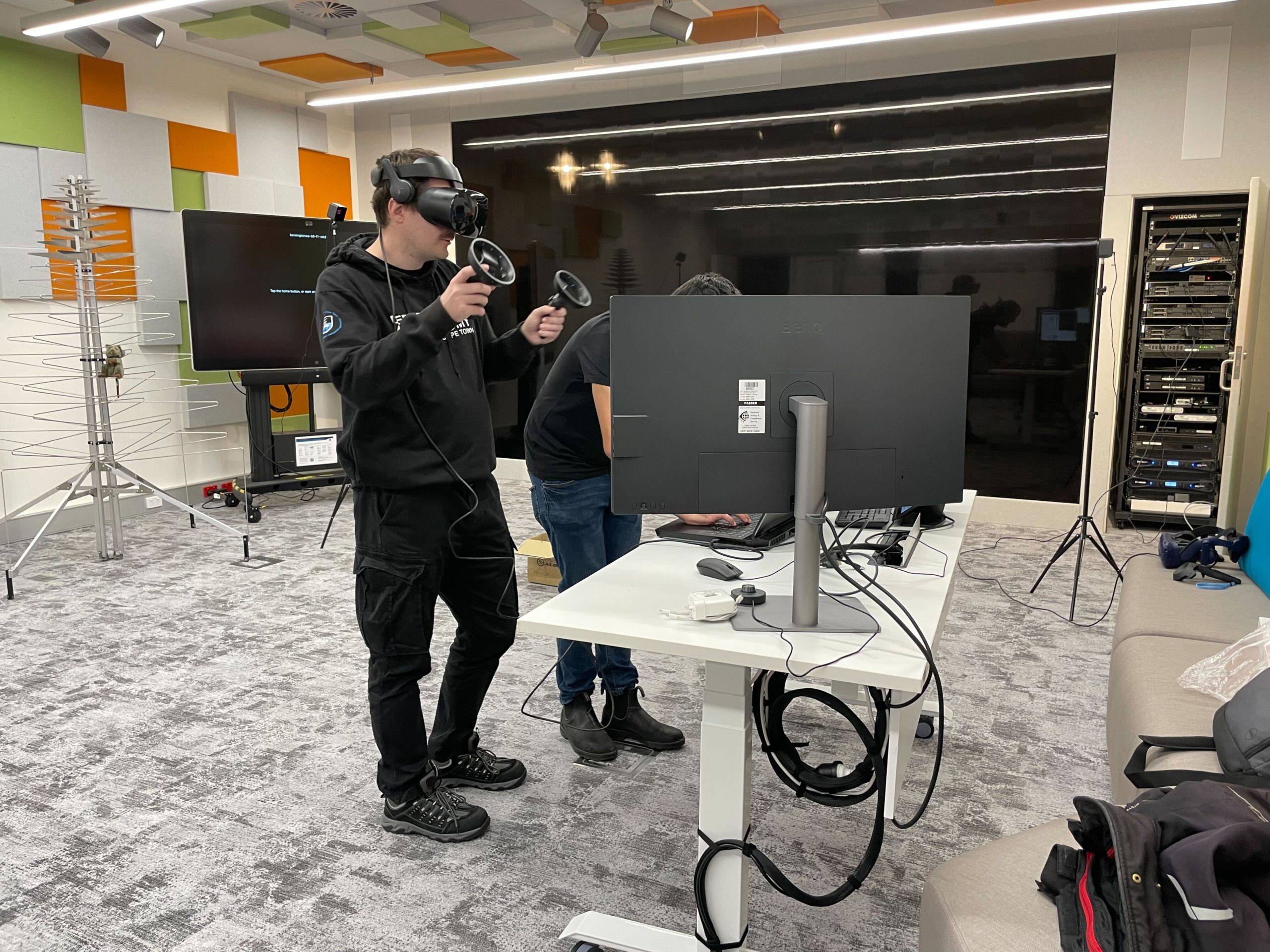
Marcin Glowacki and Karen Lee-Waddell have been collaborating with the Pawsey Visualisation Lab team to view WALLABY datacubes in VR. This photo was taken during initial testing of new software that streams the VR viewing software, iDaVIE-v, and the datacube, hosted on Pawsey’s infrastructure to a separate machine. Eventually, this system will enable WALLABY members to stream WALLABY products with their own VR systems remotely! This is an ongoing effort.
A demo of iDaVIE-v at Pawsey’s Visualisation Lab is being planned as part of the WALLABY Busy Week in August.
TWG 7 – WALLABY Cat
by Tristan Reynolds, Austin Shen and Manu Parra-Royon
We hope the team is finding the WALLABY database easy to access and use for analysing and downloading source data products. All of phase 1 and several fields from phase 2 are now available to the team (and check back regularly as new sources continue to be added!). Please let Austin Shen or Tristan Reynolds know if you run into any problems. Kinematic models are not yet available in the database, as we have been preparing for the public data release, but these should hopefully be added in the coming months. With the favourable referee reports for the data release papers, we have also been preparing the final data product files (source catalogue, moment maps, spectra, kinematic models, etc.) for public release through CASDA and CADC.
Technical Updates
The technical side of the WALLABY Cat group have been developing a system for automatic post-processing of WALLABY data as it becomes available on CASDA, and improving tools for access to, and distribution of, advanced data products within the team.
Post-processing
We have developed the first iteration of an event-driven system to triggering post-processing workflows. A collection of long-running services monitor the current state of the survey, and decides how to process new observations when they are made available through the archive. The README file in this repository covers the architecture and high-level strategy. This is the best place to go if you would like to learn more.
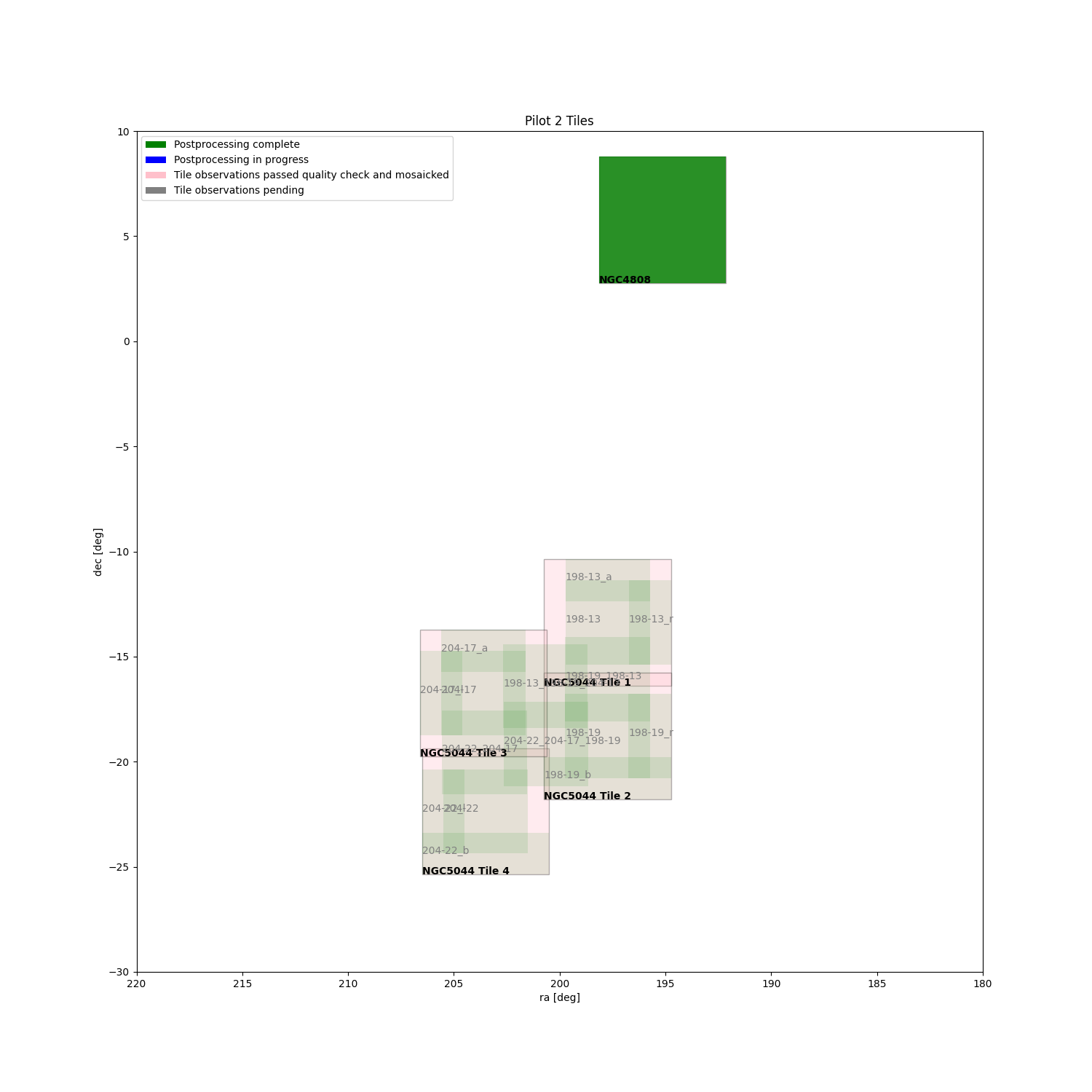
The regions of the sky that are covered by the current system are shown in the diagram below (Figure 9). The code written for the regions shown has been tested and used to process all Pilot Phase 2 data that is currently available. There is ongoing development required for covering corners of tiles, minimising overlap at lower declination values, and an entirely new strategy for the polar region. We expect to make good progress on this during the WALLABY busy week.
We have also developed a simple web application for reporting the state of post-processing activities, which is available at https://wallaby.aussrc.org. Currently it is just a simple matplotlib image that extracts state information from our system, but we intend to improve this (all ideas are welcome – please get in touch). An additional quality check step is required before they are released internally through the notebook system.
Data replication
As part of the technical sub-working group, a small subset of the regional centre network (AusSRC, CIRADA [Canada], and the Spanish SRC prototype at the IAA-CSIC [Spain]) have been implementing a distributed storage replication service for advanced data products from WALLABY. This allows the generation of source finding, kinematics and image cut-outs products at different locations to be accessed throughout the network at centres locally. For example, currently we have been able to distribute source finding products from the AusSRC to both CIRADA and the Spanish SRC prototype for Pilot Phase 2 data, and in this context, each site has the ability to push data into the network to be replicated to others. Next steps are to retrieve kinematic models of validated sources from CIRADA to other both locations. We show a schematic of the data distribution and replication system in Figure 10.

SWG 1 – Galactic HI and High Velocity Clouds
by Helga Dénes and Bi-Qing For
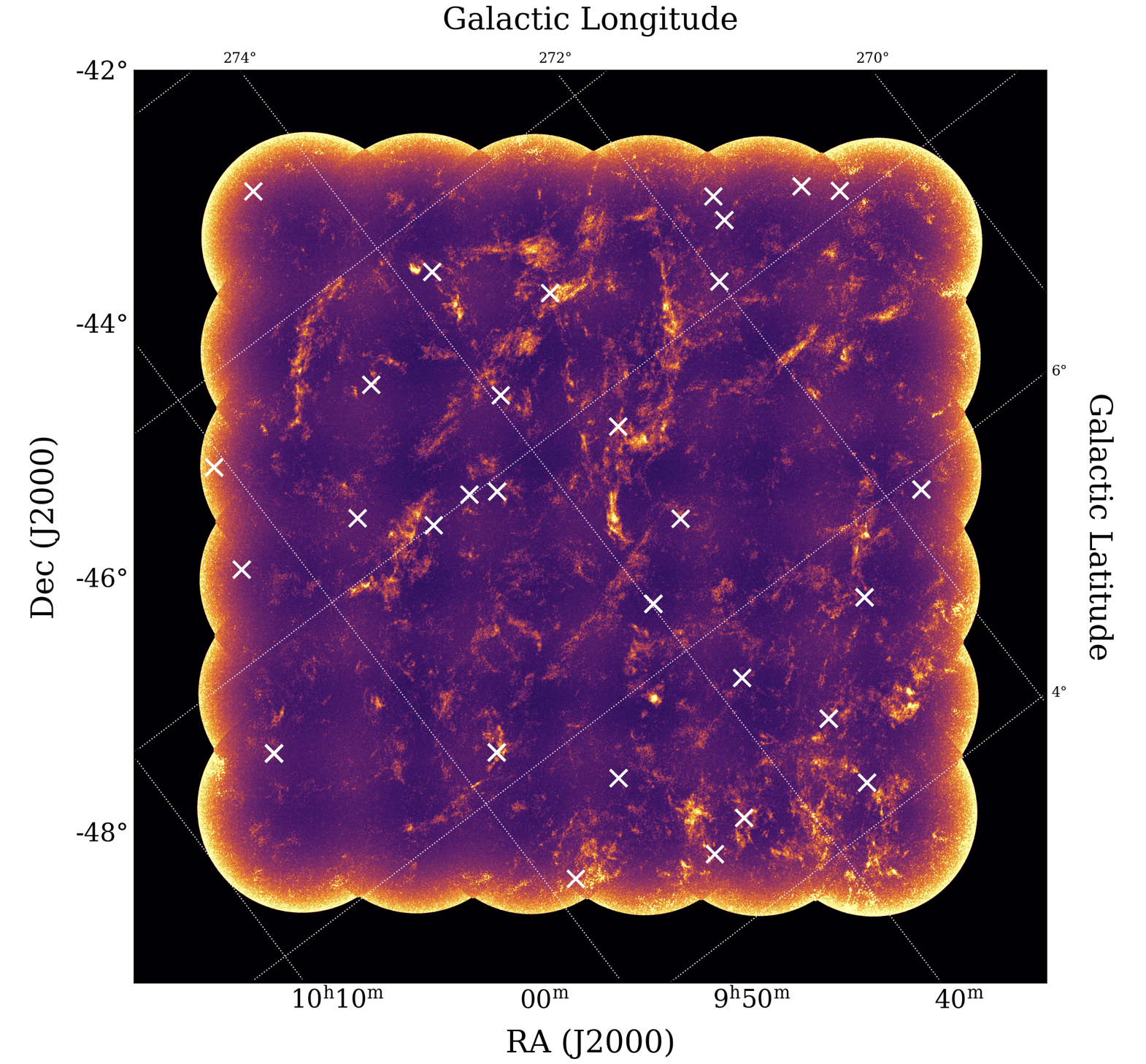
Since the last newsletter SWG 1 has participated in the discussion about the final survey footprint and continued validating the Milky Way data cubes of the WALLABY Phase II Pilot Survey. Of particular interest to SWG 1 was the first footprint of the Vela field. This field was observed at a higher, 2 km/s, velocity resolution compared to the other Wallaby fields (4 km/s) to test commensality with the GASKAP survey. The Milky Way data cube of the Vela field is of good quality, with an average rms per channel of 6.1 mJy/beam. Figure 11 shows the peak intensity map of the data cube, with plenty of Galactic HI emission from the warm gas. Figure 12 shows some examples of Galactic HI absorption from the cold component of the HI gas. Thanks to the better velocity resolution, we are able to better resolve the individual components and the dynamics of the gas.
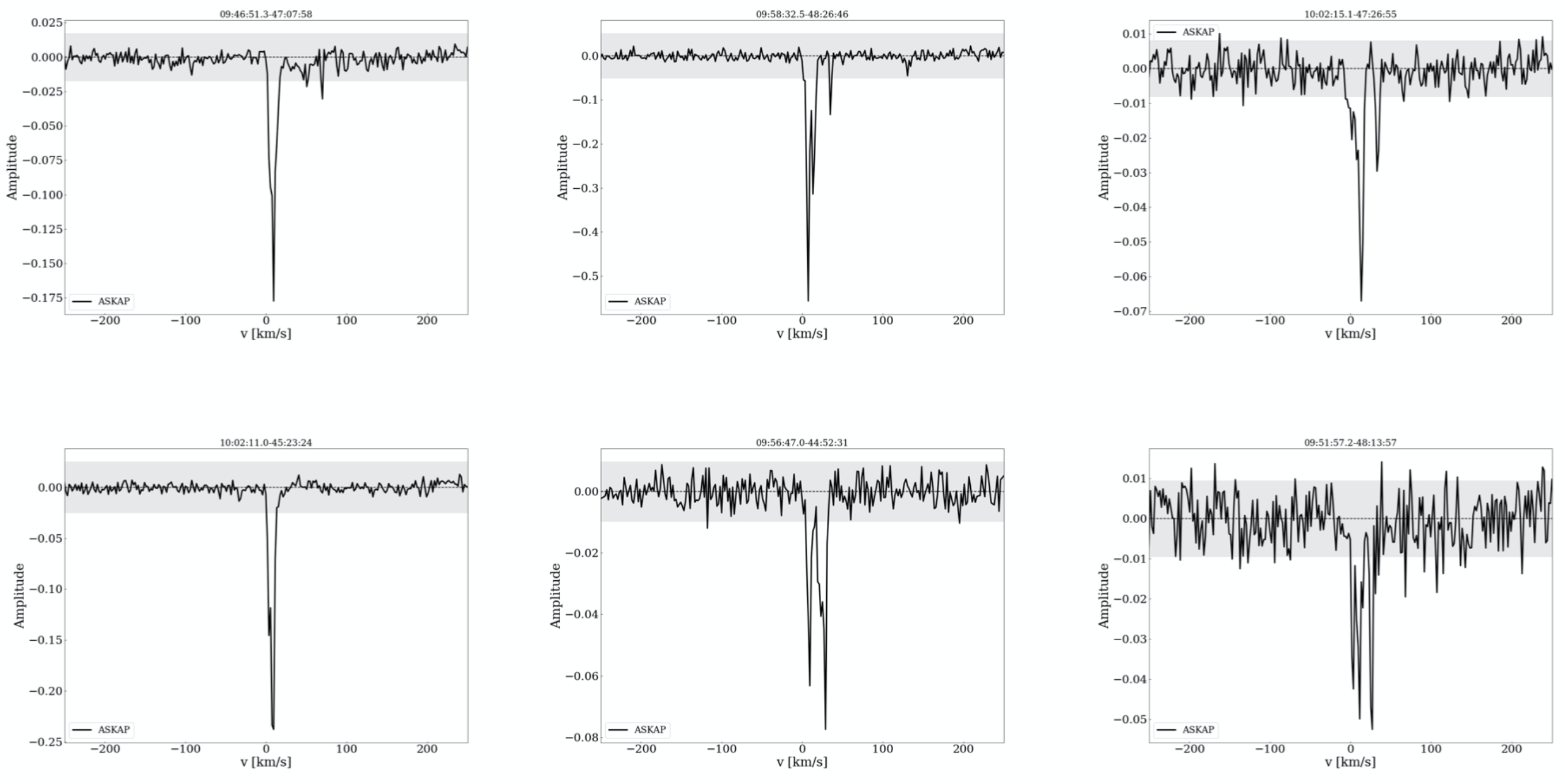
Upcoming Meetings
2022 August 22-26: WALLABY Busy Week (Perth, Australia with online attendance options)
2022 October 11-13: 8th ACAMAR Workshop (online)
WALLABY monthly Science Meeting on the third Thursday of the month alternating between European and North/South American friendly times (online)
WALLABY Publications
Feb 2022 – Aug 2022:
- Lee, Bumhyun; Wang, Jing; Chung, Aeree; Ho, Luis C.; Wang, Ran; Michiyama, Tomonari; Molina, Juan; Kim, Yongjung et al., 2022, ALMA/ACA CO Survey of the IC 1459 and NGC 4636 Groups: Environmental Effects on the Molecular Gas of Group Galaxies, accepted for publication in The Astrophysical Journal Supplement Series, eprint arXiv:2204.06022
